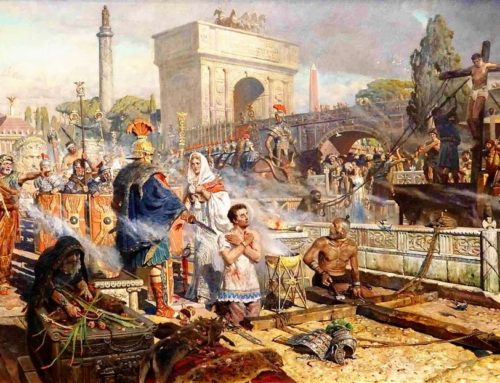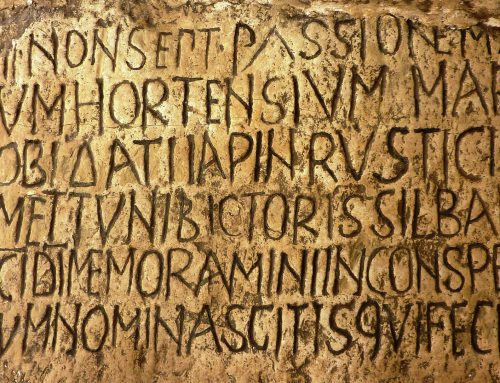From the earliest times the fertile Esdraelon plain in Galilee has been criss-crossed by paths and caravan trails. Travellers coming down from Mesopotamia and Syria, after following the shoreline of Lake Gennesareth, struck westwards across the plain towards the Mediterranean and so on to Egypt. Those coming from the south, from Mount Hebron, following the route from Bethlehem, Jerusalem and Samaria, travelled northwards, passing close to Nazareth. The solitary peak of Mount Tabor towers over the plain.
If Mount Tabor were part of a range of hills it would attract no particular attention, standing as it does just 558 metres above sea-level. But it is a single isolated peak, whose conical shape suggests that it could be volcanic, though in fact it is not. It stands over 300 metres higher than the surrounding land and this makes it singularly imposing. It is also noticeable for the vegetation growing up its sides: holm-oaks, wild plants, and in spring, lilies of different kinds. From its top, a broad level space where cypress-trees grow in abundance, a beautiful panorama opens to view. Because of this, Mount Tabor became a place of worship for the Canaanites, who worshipped their idols on the hill-tops. It also made a good site for military fortifications, as a watch-tower over the area. Traces of human presence on Tabor go back seventy thousand years.
Tabor in literature
According to the Old Testament it was at Mount Tabor that Deborah gathered ten thousand Israelites in secret, commanded by Barak, who put Sisera’s army to flight (cf. Judges 4:4-24). The Midianites and Amalekites killed Gideon’s brothers there (cf. Judges 8:18-19). After the Promised Land had been won, Mount Tabor marked the boundary between the tribes of Zebulon, Issachar and Nephthali (cf. Joshua 19:10-34), who held it to be a sacred place and offered sacrifices on its summit (cf. Deut 33:19). The prophet Hosea denounced this worship because it was not just schismatic but actually idolatrous (cf. Hos 5:1). Finally, the fame of Tabor is shown by the fact that it is used as an image in Old Testament literature. The psalmist speaks of Tabor and Hermon together as symbolizing all the hills of the earth (cf. Ps. 89[88]:12). Jeremiah compares Tabor to the way Nebuchadnezzar loomed over his enemies (cf. Jer 46:18-26).
Although Mount Tabor is not named in the New Testament, it was identified very early on as the place of our Lord’s Transfiguration. Now about eight days after these sayings he took with him Peter and John and James, and went up on the mountain to pray. And as he was praying, the appearance of his countenance was altered, and his raiment became dazzling white. And behold, two men talked with him, Moses and Elijah, who appeared in glory and spoke of his departure, which he was to accomplish at Jerusalem. Now Peter and those who were with him were heavy with sleep, and when they wakened they saw his glory and the two men who stood with him. And as the men were parting from him, Peter said to Jesus, “Master, it is well that we are here; let us make three booths, one for you and one for Moses and one for Elijah” – not knowing what he said (Lk 9: 28-33); Mt 17: 1-4; Mk 9: 2-5).
Archaeological excavations at Tabor have shown that there was a fourth- or fifth-century church there (which some ancient sources say was built by St Helena) which had been constructed on the remains of a Canaanite place of worship. Later on, the testimonies of some sixth- and seventh-century pilgrims speak of three basilicas – in memory of the three booths that St Peter had proposed to make – and large numbers of monks living there. In confirmation of these reports, a mosaic floor has been found dating from that time, and in 553 the Council of Constantinople established a bishopric of Tabor. During the Muslim domination this monastic or hermit community dwindled away, and in 808 AD the churches were looked after by eighteen religious whose bishop was Theophanes.
From 1101 onwards, until the end of the Latin Kingdom of Jerusalem, a Benedictine religious community lived on Mount Tabor. They restored the church and built a large monastery, protected by a fortified wall. However, this was not sufficient to defend them against the Saracens, who overran the abbey and turned it into a fortress in 1211-1212. Although Christians were allowed to return a little later and take possession of the site, their basilica was again destroyed in 1263 by the soldiers of Sultan Baibars.
Deserted until the 17th century
Mount Tabor was deserted until the arrival of the Franciscans in 1631. They took charge of the property from then on, though not without difficulties; they studied and strengthened what was left of the buildings, but it took another three centuries before a new basilica could be built. It was completed in 1924.
Today pilgrims can climb Mount Tabor following a winding road which was made at the beginning of the twentieth century to enable building materials to be carried up to the new basilica. As they reach the top they come to the Gate of the Wind, or Bab el-Hawa in Arabic, a remnant of the thirteenth-century Arab fortress, whose walls surrounded the whole flat space of the summit. On the north side stands the Greek Orthodox area and on the south is the Catholic part, looked after by the Custody of the Holy Land
From the Gate of the Wind, a long avenue lined with cypress-trees leads to the Basilica of the Transfiguration and the Franciscan monastery. In front of the church the ruins of the twelfth-century Benedictine monastery may be seen, as well as traces of the Saracen fortress. Indeed, the fortress was built on the foundations of the Crusaders-era basilica, as is the present church, which was built on the plan of the preceding one.
The façade, with its great arch between two towers and its triangular gables, welcomes visitors with an invitation to lift up their souls. This sensation intensifies as they go through the bronze gates: the central nave, separated from the side aisles by great semi-circular arches, becomes a stairway carved out of the rock which goes down to the crypt, and high above it stands the sanctuary, with an apse behind it with a mosaic of the Transfiguration against a gold background. The mystery of the scene is heightened by the special quality of the light, which enters through windows in the façade, the walls of the central nave, and the apse of the crypt.
The plan of the basilica followed the lines of the previous churches on that spot. By the door, the two towers were built over some chapels with mediaeval apses, now dedicated to the memory of Moses and Elijah; and in the crypt, although the original vault from the Crusades era was later covered with a mosaic, the altar is the original one and parts of the original masonry are still visible in the walls. In addition, a small grotto was recently discovered to the north of the church, under the spot which had been identified as the refectory of the mediaeval monastery. On its walls were some Greek inscriptions, and symbols including crosses, possibly traces of the Byzantine monks who once lived on Mount Tabor.
Jesus strengthens the Apostles’ faith
At the Transfiguration, Jesus showed his glory as God, and thus confirmed St Peter’s recent confession of faith: “You are the Christ, the Son of the living God” (Mt 16: 16; cf. Mk 8: 29 and Lk 9: 20). In this way he also strengthened the Apostles’ faith in advance, to face his coming Passion and Death (cf. Catechism of the Catholic Church, nos. 555 and 568), which he had already begun to announce to them (cf. Mt 16: 21; Mk 8:31; and Lk 9: 22). The presence of Moses and Elijah is highly significant: both of them “had seen God’s glory on the Mountain; the Law and the Prophets had announced the Messiah’s sufferings” (Catechism of the Catholic Church, no. 555). The Evangelists also tell that as Peter was still speaking, proposing to make three booths, “a bright cloud overshadowed them, and a voice from the cloud said,
‘This is my beloved Son, with whom I am well pleased; listen to him’” (Mt 17: 5; cf. Mk 9: 7; and Lk 9: 34-35).
Commenting on this passage, some Fathers of the Church underline the difference between the representatives of the Old Testament – Moses and Elijah – and Christ: “They are my servants, this is my Son (…) I love them, but this is my Beloved: therefore, listen to him (…) Moses and Elijah spoke of the Christ, but they are servants like you; this is the Lord, listen to him” (St Jerome, Commentary on St Mark’s Gospel, 6).
For Pope Benedict XVI, “This one command brings the theophany to its conclusion and sums up its deepest meaning. The disciples must accompany Jesus back down the mountain and learn ever anew to “listen to him” (Jesus of Nazareth. From the Baptism in the Jordan to the Transfiguration, London: Bloomsbury, 2007, p. 316).
As we read the Gospel and try to meditate on it in our prayer, it will help us to ask the Holy Spirit for light, for him to come and help our desires. We can say, in St Josemaría’s words: “Lord, we are ready to heed whatever you want to tell us. Speak to us: we are attentive to your voice. May your words enkindle our will so that we launch out fervently to obey you” (Holy Rosary, Fourth Luminous Mystery).
J. Gil on josemariaescriva.info




Leave A Comment
You must be logged in to post a comment.